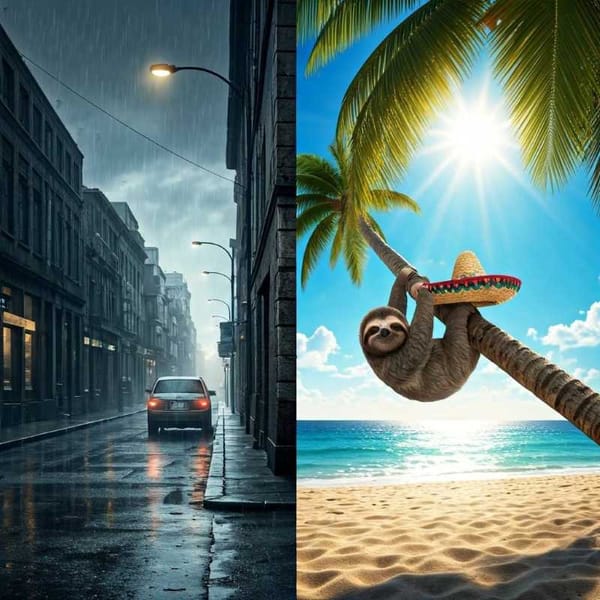The Plaza Mayor of Madrid, hundreds of years of history
In its origins, it was the Plaza del Arrabal, in the suburb of Santa Cruz, outside the walled enclosure of the city. The Plaza was formed by a market without any order or concert, under the arcades of some of the houses of the merchants who lived in this area, mostly Jews.

The Plaza Mayor of Madrid is currently one of the most emblematic places of the capital, the scene of important events, a favorite place for locals and tourists, merchants and strollers, and the curious. All together make the Plaza Mayor a unique place, where tradition coexists with modernity, in an urban theater in which each visitor to the square is the protagonist of his own story: a theater that, in the words of Alexandre Dumas, was the theater with the most beautiful vault in the world: The sky of Madrid.
History of the Plaza Mayor
The history of such an iconic place dates back to 1463, when Henry IV, brother of Isabella the Catholic, granted the town of Madrid the privilege of holding a fair every month, held in the vicinity of the disappeared church of El Salvador. Finally, it was moved to the Plaza del Arrabal, which was gradually surrounded by well-built houses: they ennobled the area, giving it a more urban aspect. In 1494, the Plaza del Arrabal was regularized in urban and commercial terms, according to royal regulations.
Philip II decided, in 1561, to turn Madrid into the capital of his empire. This fact would mark the physiognomy, the destiny of the future Plaza Mayor. It went from being a marginal, isolated area to the commercial and social center of Madrid, changing the urban axis of the town. The monarch decided in 1581 to give the square the necessary solemnity for a place that was the great stage for the commercial, cultural and political events of the time.
The initial design was entrusted to the architect Juan de Herrera. In 1591 the square of the suburb was already the Plaza Mayor, a space with wooden arcades. At the beginning of the 16th century, it had a dilapidated, ramshackle appearance; Philip III ordered the restructuring of the Plaza Mayor, where he had been proclaimed king. In 1608 Francisco de Mora was commissioned to "square the square". It would not happen until 1617 when his nephew Juan Gómez de Mora began what would become the great Plaza Mayor of Madrid, framed within a rectangle 152 meters long by 94 meters wide.
The measurements were not chosen at random. They were the result of applying the golden section to the proportions of the space. As the Plaza Mayor had been built on an artificial platform, over the old Luján lagoon, Gómez de Mora solved the difference in level between the Plaza and the Cava de San Miguel with a series of dwellings that served as wall health. The difference in level was bridged by a stairway that connected the Cava with the Plaza through an arch, destined to become one of the icons of the city: the famous Arco de Cuchilleros (Cuchilleros Arch).
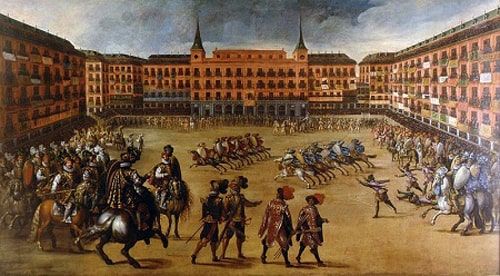
Architectural landmark
The stores in the Plaza Mayor were located in its arcades in the form of a commodities exchange. The distribution was adjusted to the wishes of the guilds: on the west side, the cloths; on the south, the Casa de la Carnicería; to the east, the hemp and silks; to the north, the linen, cloth, and shoemakers, the Casa de la Panadería, silks and threads, with the exception of the first floor of the Casa de la Panadería, which housed the Peso Real and Fiel Contraste (Royal Weight and Faithful Contrast). On the second floor of the Casa de la Panadería was built the royal salon overlooking the Plaza through the royal balcony from where the monarchy attended the events as privileged spectators.
The Plaza Mayor was a great architectural landmark, as it became the largest public space in Madrid. Throughout its 400-year history, it has served as a stage for all kinds of celebrations. It was inaugurated on May 15, 1620, with the acts of beatification of San Isidro. Afterward, it was the scene of bullfights, cane games, religious celebrations, royal weddings, processions, tournaments, masquerades, theatrical performances, carnivals, dances, tarascas, fire castles, acts of faith, executions, coronations...
The Plaza Mayor has suffered three major fires (1631, 1672, and 1790). The last fire was devastating: it razed the entire Plaza to the ground. It was rebuilt by Juan de Villanueva, who respected the traces of Gómez de Mora, although he lowered the height of the buildings from five to three floors. The height of the Plaza was unified using a continuous slate roof, dotted with dormers. The most notable novelty was the complete enclosure of the Plaza, with a series of access arches.
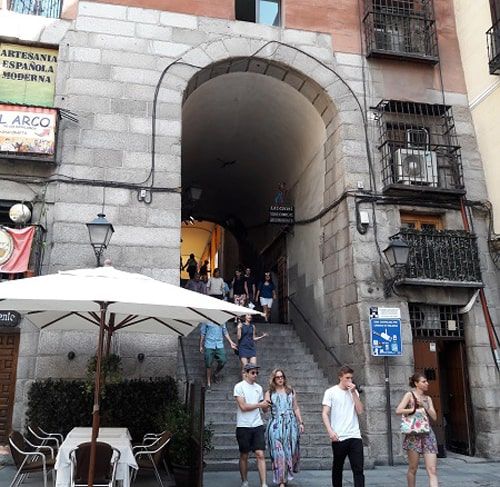
Illustrious visitors
In the 19th century, Spain was visited by dozens of travelers, some of them moved by the romanticism of the time. Among those who arrived in Madrid, in 1832, was George Borrow, Don Jorgito "the Englishman", to evangelize the gypsies. And as a "curious impertinent" he wanted to witness a public execution in the Plaza Mayor. The spectacle traumatized him, leaving a chronicle in his book "The Bible in Spain", in chapter XII: "A long time we had already been waiting in the middle of the crowd to see the execution.
We had been waiting in the crowd for a long time, when the first prisoner appeared, mounted on an ass, without saddle or stirrups, so that his legs almost dragged him along the ground. He wore a sulfur-yellow tunic, with a red cap, high and pointed, on his shaven head. He held in his hands a parchment, on which he had written something, I suppose the confession of his crime. Two priests carried the donkey along the branch; two others walked on either side, chanting litanies...".
During the reign of Isabel II, the Plaza lost its function as a place for spectacles, for which it was conceived, and the central space was remodeled, turning it into a French-style garden. Following the Gallic urban fashion, it was paved, landscaped, and adorned with fountains, and at the request of the then councilman of Madrid, Mesonero Romanos, the equestrian statue of Philip III (until then located in the Casa de Campo) was placed in the center.
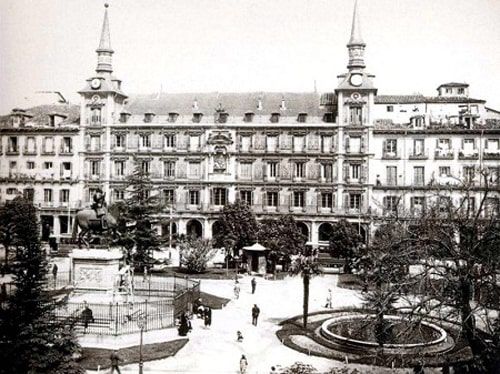
Neoclassical Layout
The new Plaza with a neoclassical layout would have final dimensions of 120 by 90 meters, with 114 arches including eight access, 377 balconies, four towers, and a total of 76 attics. The Plaza Mayor converted into the neuralgic center of Madrid, began to be an obligatory place of passage for merchants, shoppers, tourists, strollers... No person lived or was in Madrid who did not end up passing through it. Even since 1877, it housed the headboards of some of the main streetcar lines of the city, with the activity until 1956.
In the twentieth century, between 1921 and 1935, reforms were carried out in the houses to consolidate the balcony. But the most important reform was carried out in the 1960s when the slate roofs were recovered and the dormers were regularized. It was closed to vehicular traffic and a subway parking lot was created under the Plaza itself, eliminating the landscaped areas and street furniture to recover the grandiose scale of the original project. The last of the major actions in the Plaza Mayor was carried out in 1992. The walls of the Casa de la Panadería were decorated, replacing the old and deteriorated frescoes.
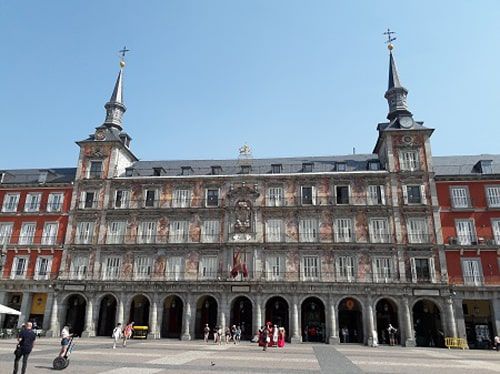
Tourism
At the beginning of the 21st century, the Plaza Mayor of Madrid is a festive, colorful space, partly occupied by the numerous terraces of the bars (the locals are in the arcades), where you can taste the typical calamari sandwiches, once at popular prices, today with exaggerated prices. On Sundays and holidays, a busy numismatic and philatelic market expands along the arcades of the square: coin and stamp collectors buy and sell their best pieces.
In the Plaza Mayor, the local population mixes, including the residents of Madrid, whether they are cats or not, with all kinds of tourists from all over the world. The most exotic come from the Far East, with their cameras ready to capture every detail of everything that happens in the streets or historic buildings. In such a crowded space, which is entered and exited through all the canvases, every space is occupied: near the exit to Toledo Street, there are the portrait artists who, in a few minutes, can leave a sample of their art for those who want to immortalize their face, as a mirror of the soul.
Attached to the facade of the Bakery House, tourists can portray themselves as bullfighters or manolas standing behind the corresponding costumes ... amid all that bustle, a strange Spiderman, a pot-bellied spider man who amazes children and adults with his shabby costume, swarms. Not far from this strange comic book character can be seen other life-size stuffed animals, with other characters. There is also no shortage of "pomperos" who delight children by generating huge soap bubbles.
Although the Plaza Mayor no longer hosts autos de fe, during Holy Week its space is crossed by up to three nocturnal processions, on their street routes, where devotion is mixed with festivities. Closing the year, some booths define the Christmas Market, where you can buy everything you need to assemble a good tree, following the tradition of the Nordic countries; or install a whole nativity scene, including caganer (which has left its Catalan limits to become universal).
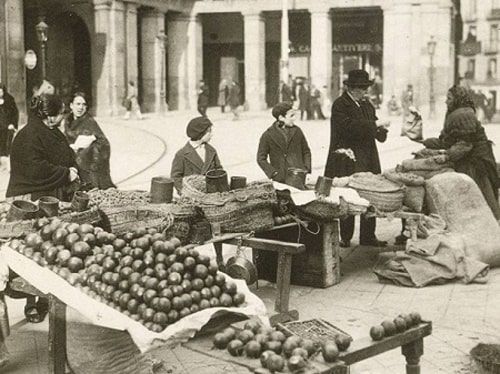
The Plaza Mayor is an emblem of the city. No one who lives in Madrid, or has traveled to the capital, has failed to visit it.
Text and photos: Pablo Torres




